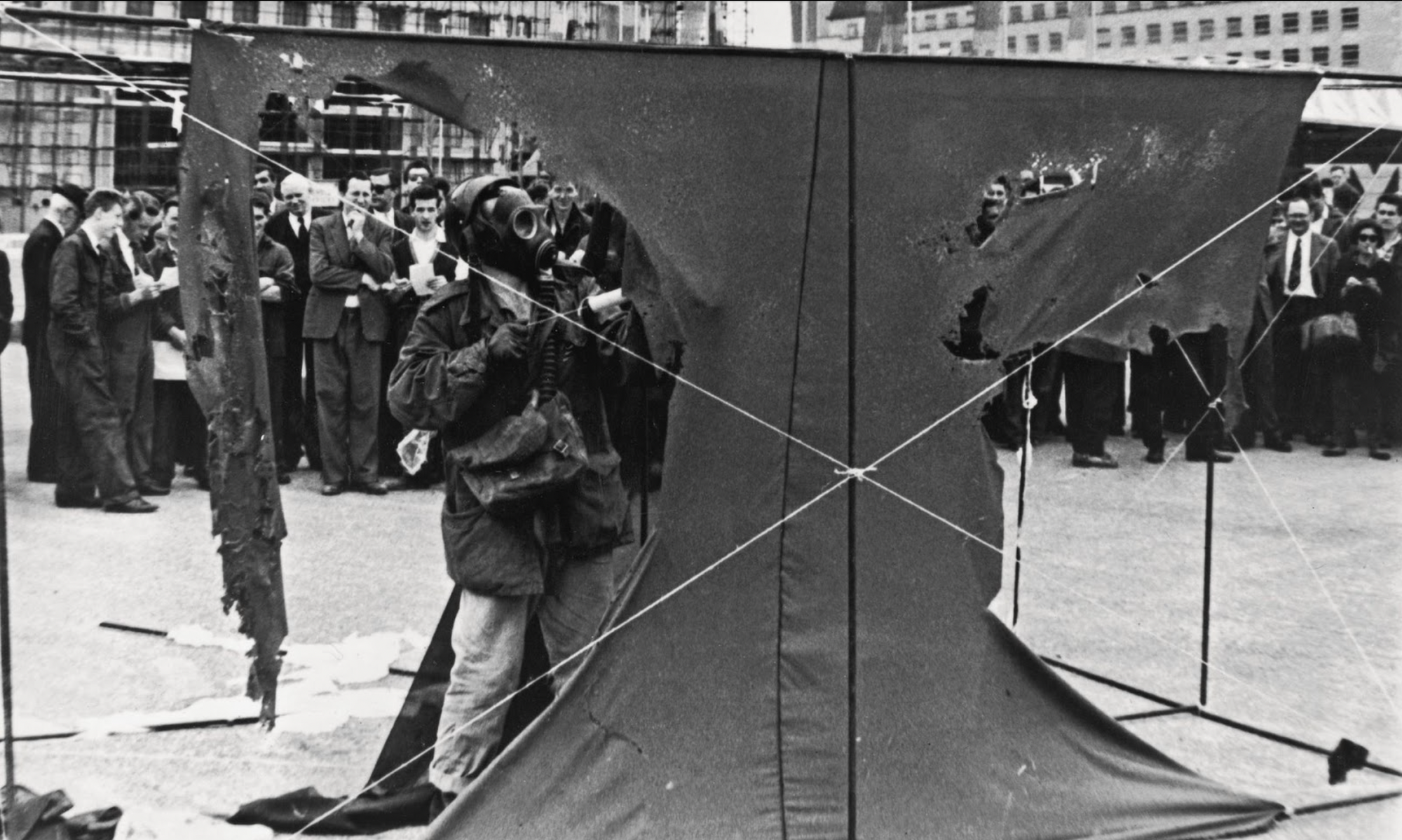
Gustav Metzger, Auto-Destructive Art, 1960; Photography by Keystone © Getty Images.
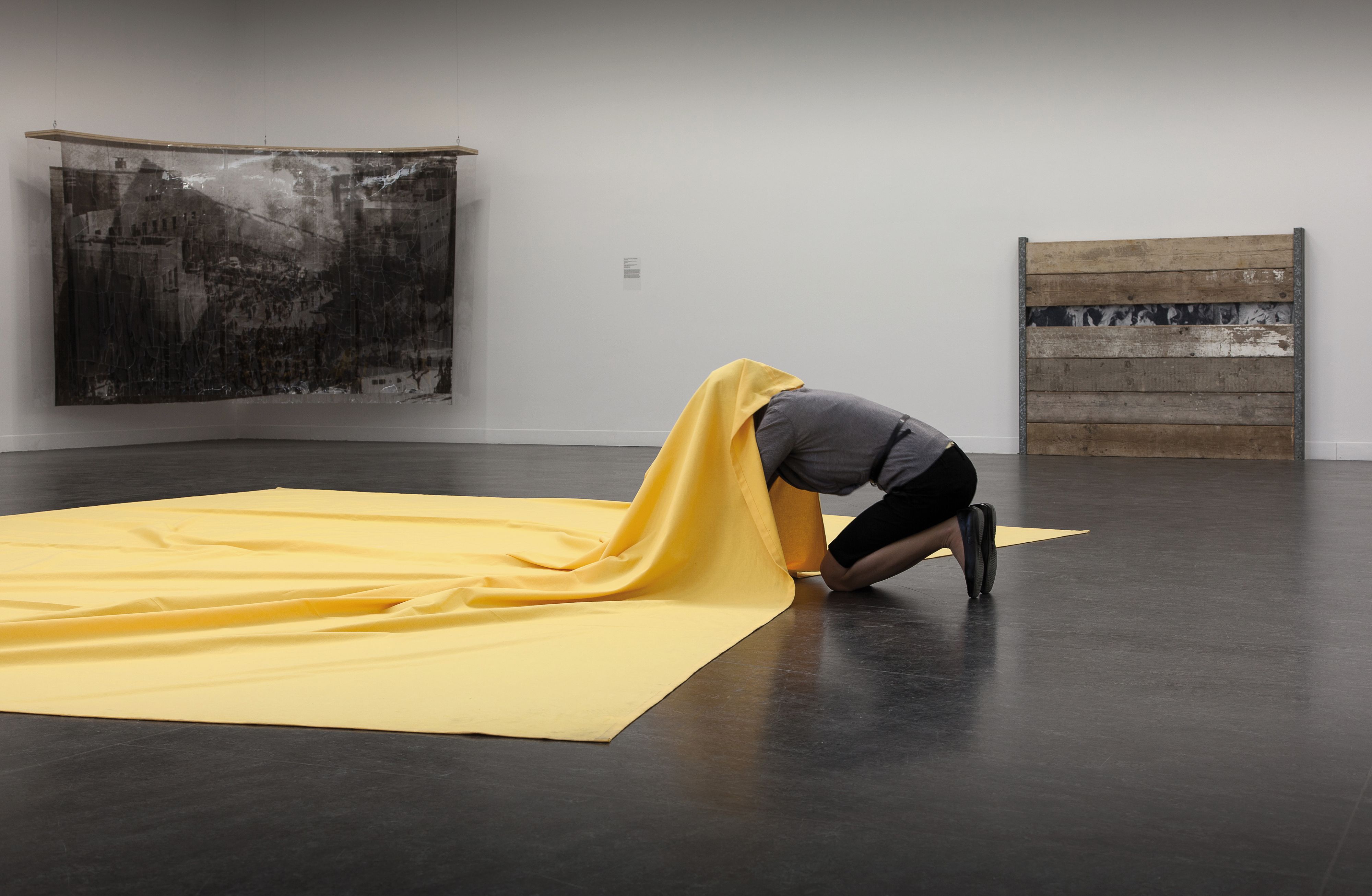
Gustav Metzger, Act or Perish! Gustav Metzger. A Retrospective, 2015. Installation view at Centre of Contemporary Art, Toruń. Photography Wojciech Olech. © The Estate of Gustav Metzger and The Gustav Metzger Foundation. Courtesy The Estate of Gustav Metzger and CoCA Toruń.
After Hurricane Idalia hit the East Coast of the United States this year, I found myself anticipating one of the least depressing yet most reliable consequences: the recirculation of a video showing a shark in a Florida swimming pool. It’s an inevitable piece of fake news that’s often greeted with exclamatory headlines and is occasionally commented on by gullible senators. I’m fascinated by it, perhaps because there’s nothing technically wrong here — a shark swimming around in a body of water, close to its“natural environment.” The eeriness comes from our anthropocentric view: an orderly human space suddenly contains an excessive presence; the line between the “natural” and the “environment” has been crossed. The fact that this video is dredged up after each wave of storm inundations says something not only about our avoidant climate-disaster mindset but also our concerns around built space — it hints at an architectural anxiety. The fascination with enclosing a microcosm of the natural world within human-made structures has spurred some of the wildest feats of engineering, from Göbekli Tepe in modern-day Turkey to Biosphere 2 in Arizona. But these are attempts to order space to human needs and are therefore extremes whose logic is based in the concept of the “built environment” and that make visible its fundamental conceptual flaw: to enclose is also to exclude, to maintain that line between the “natural” and the “environment.” Despite all the talk of ecologically responsible practices, nature has no place in our built space.

Gustav Metzger, Auto-Destructive Art, 1960; Photography by Keystone © Getty Images.
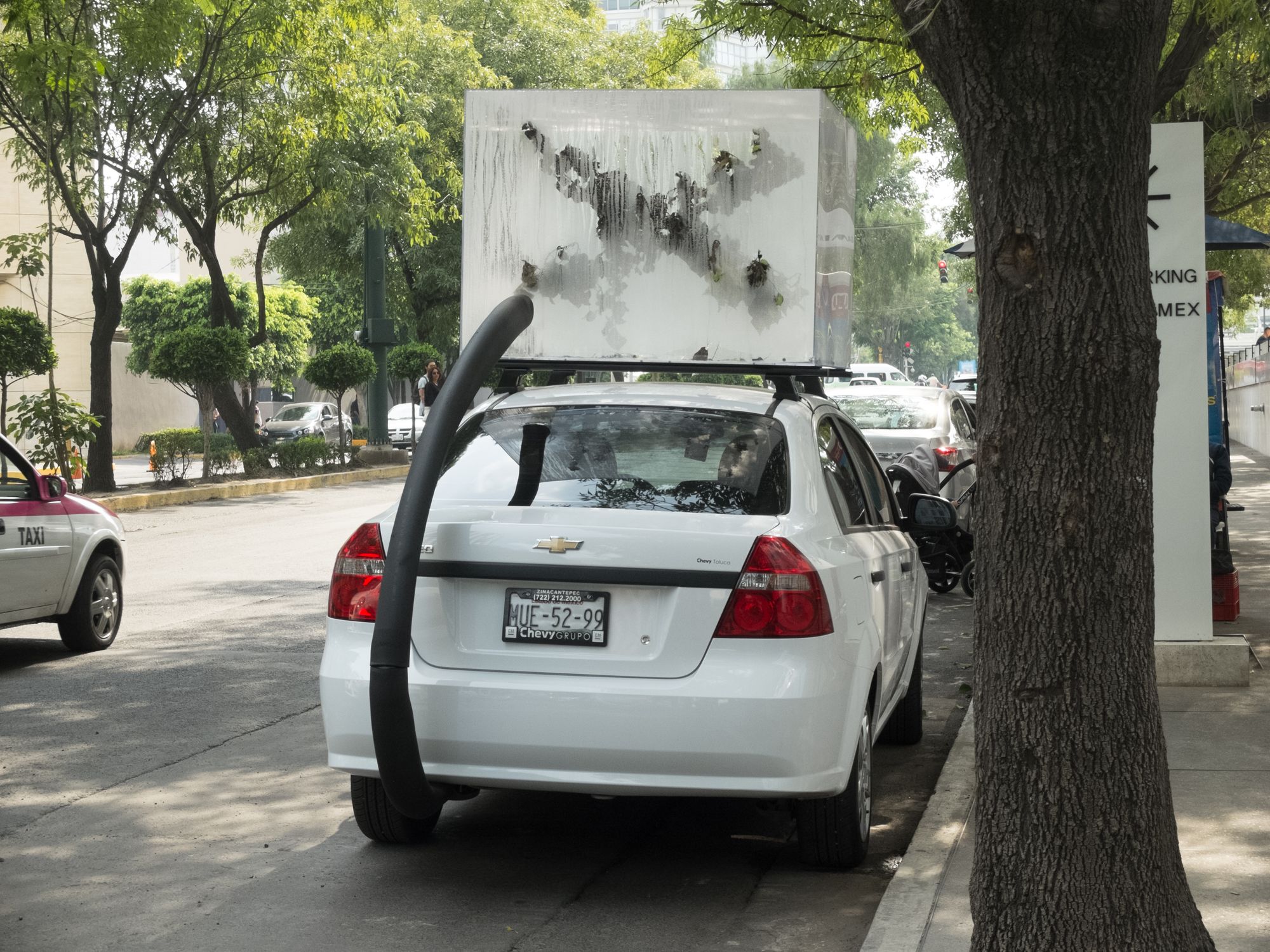
Gustav Metzger, Mobbile, 1970/2015. Installation view, Fundación Jumex, We Must Become Idealists or Die, Mexico City, Mexico, 2015. Photography by Colin Swan. © The Estate of Gustav Metzger and the Gustav Metzger Foundation. Courtesy the Estate of Gustav Metzger and Fundación Jumex.
The very concept of “environment” is an elision, taking a part for the whole, substituting a controlled system for the vast, unpredictable entity that is “nature.” Or, as the German-born artist and activist Gustav Metzger (1926–2017) once put it, “you cannot make nature, and if you could, it wouldn’t be nature.” If anyone understood how going to extremes could prove socially useful, laying bare political flaws and humanity’s depths, it was Metzger. Like so much of Metzger’s work, his thinking on the environment versus nature was radically visionary and yet widely overlooked.
Metzger was a hardcore anti-capitalist who resisted the gallery system and rejected the art market. This stance would make it difficult for any modern artist to establish much name recognition, but Metzger went one step further: in 1959 he pioneered the concept of Auto-Destructive Art with a manifesto that railed against the commodification of work and suggested the need for post-war catharsis through public projects that embraced destruction, decay, and disorder. One of the constraints, which he would continue to respect for much of his long career, was that no piece of Auto-Destructive Art should last more than 20 years. This was both a philosophical position and a massive “fuck you” to the gallery system. Radical that he was, Metzger resisted the entire notion of a white-cube legacy, yet his practice has more relevance today than ever before.
As a young refugee in the U.K., after escaping Nazi Germany on a Kinder transport, Metzger spent much of his teens and early 20s traveling the country, living in poverty, and trying to find away to pursue the arts. At the age of 24 he visited the Shetland Islands, where he was struck by the stillness and the clean air. His notebook from this period contains a short list, “The Most Dangerous Elements in Modern Society, 1950,” that simply reads, “pollution, noise, cars.” Indeed Metzger would become obsessed with the car and its toxic fumes, writing screeds against the automobile and designing artworks that reflected his fears of pollution. In early iterations, these featured plant-filled terrariums strapped to the roofs of cars, a deadly tube feeding from the exhaust pipe into the cubed “environment” in which, after a few days on the road, the plants would die. It was his version of kinetic art, taking, in typical Metzger fashion, the basic tenets to their furthest extremes (in 1967 he would be convicted at the Old Bailey on charges of “indecent exhibition” after helping the artist Hermann Nitsch produce a gory performance involving a lamb’s carcass and film footage of male genitalia).
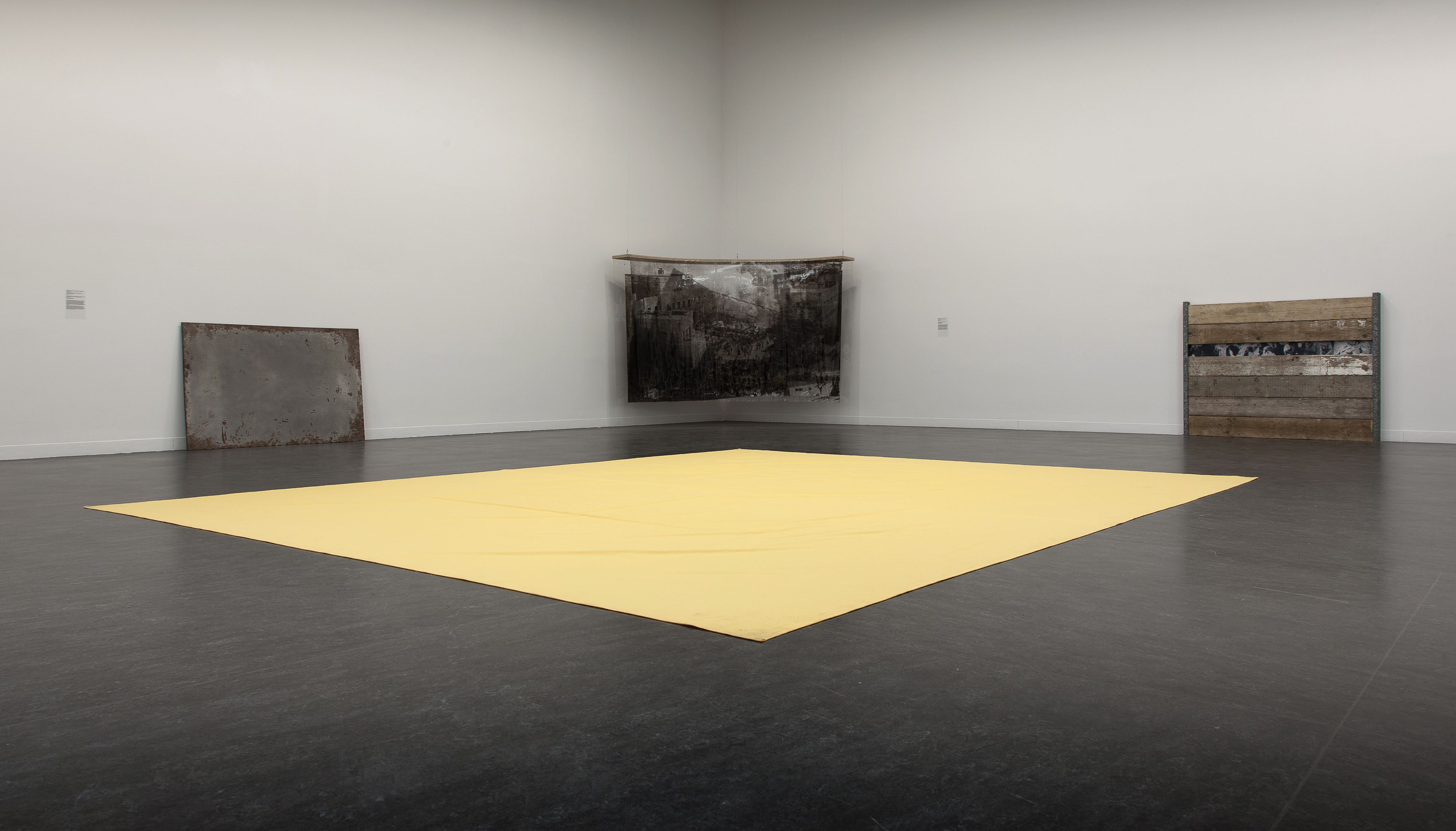
Gustav Metzger, Act or Perish! Gustav Metzger. A Retrospective, 2015. Installation view at Centre of Contemporary Art, Toruń. Photography Wojciech Olech. © The Estate of Gustav Metzger and The Gustav Metzger Foundation. Courtesy The Estate of Gustav Metzger and CoCA Toruń.
Decades later, while watching Claude Lanzmann’s Shoah and remembering seeing his father marched off to the death camps, Metzger experienced a moment of stark recognition. As the film discussed early Nazi experimentations with hermetically sealed, exhaust-filled vans — precursors to the gas chambers — he suddenly understood that, “this extreme revulsion I had developed [for cars] was rooted subconsciously in my childhood experience.” Metzger’s obsession with pollution morphed over time, finding its most ambitious expression (perhaps naively so) in the unrealized Project Stockholm, June (Phase 1), which he conceived for the inaugural United Nations Conference on the Human Environment in 1972, and proposed again 20 years later as Earth Minus Environment for the 1992 U.N. Conference on Environment and Development in Rio de Janeiro (aka the “Earth Summit,” the first U.N. meeting to specifically address questions of the environment). On both occasions the proposal involved erecting a rectangular polystyrene-covered enclosure surrounded by 120 cars pumping their exhaust fumes into it, the goal being to make automobile pollution visible and stir debate on the “necessary” use of fossil fuels. During Phase 2, Metzger suggested, the cars could be brought inside the cube and allowed to combust in a massive, fossil-fueled bomb.
Disillusioned by the U.N.’s lack of environmental policy-making, Metzger outlined his thinking on the topic in his 1992 essay Nature Demised Resurrects as Environment. In this attempt to disentangle the messy knot of nature and environment, he posits nature as a single but complex system that we can wonder at “in awe,” a “quagmire” built from “accretions of meaning and significance, layers of emotion, historical associations.” And though Metzger’s conception of nature is necessarily mediated through the human experience (via poetry, the arts, etc.), it does resist human influence and cannot, by definition, be constructed. Extending beyond the my opic human lens, it is not merely an aesthetic realm but also a political one: “When we observe nature, the guiding feature seems to be a kind of permission to exist, a capacity to co-exist amongst the countless forms of life.” Nature as permission and capacity — this is perhaps where Metzger draws closest to James Lovelock’s Gaia hypothesis, which envisions nature as a self-regulating organism that holds all species in balance. It is also where Metzger begins to expand on the political stakes of his argument, for an infringement on nature is an infringement on the capacity for life to exist, and vice versa.
And nature has been infringed upon, Metzger insists: once something conceived of as eternal and immutable (see here Le Corbusier), a “reassurance that life would continue,” a locus of calm where an “englobing experience was given shelter, verdancy,” nature is now the stuff of memory. In a single generation, “Nature has been turned into a hybrid: environment.” As Heidegger once put Earth and world into tension, so Metzger juxtaposes nature and environment. Metzger was concerned that environment would denature nature, breaking it up into parcels to be easily managed by economic and political elites — a shift that he saw reflected in the built environment as well. Rather than placing our architecture within nature, he noted, we now claim to place nature within our architecture — whether literally in bio-shelters or figuratively through the language of environmental sustainability. This necessitates a process of psychological distance just as much as physical exclusion, a “disarousal of emotions.” Nature’s quagmire is replaced by the simple, capitalist logic of environment — first we make money dirtying up, then we make more cleaning up. If we think we can escape this process unscathed, we’ve missed the trick. For, as Metzger says, it “is not just that nature is wiped out, it is our memory that is overturned... Not knowing is a form of erasure. It is quite different to not having.” What we miss is something much more political and metaphysical than the diversity of species. “The move against nature is a move against one’s own nature,” a disavowal of our deepest experience of life.

Gustav Metzger, Stockholm June, Phase 1, 1972/2007; Scaffolding, polyethylene sheet, 100 cars. Installation view at Sharjah Biennial, Sharjah, United Arab Emirates, 2007. © The Estate of Gustav Metzger and the Gustav Metzger Foundation. Courtesy the Estate of Gustav Metzger and Fundación Jumex.
Environment and environmentalism, Metzger argues, are the strategically bland terms of devious executives. Nature exists only in our collective past. What Metzger insists we need to be talking about instead, and urgently, is “damaged nature.” And if the past year has taught us anything, it is the impossibility of keeping damaged nature out any longer — out of our cities, our homes, and our daily fears, regardless of the state of Florida’s swimming pools. We can cling to the comfort of our built space all we want, but the fissure between nature and environment is filling with shark-infested water, ready to crack the whole system open. Our foundations remain un-surveyed, vulnerable to our own “not knowing.” It’s a rich breeding ground for anxieties — architectural or otherwise — but, as Metzger knew so well, the best way to dispel fear is to face destruction head-on.
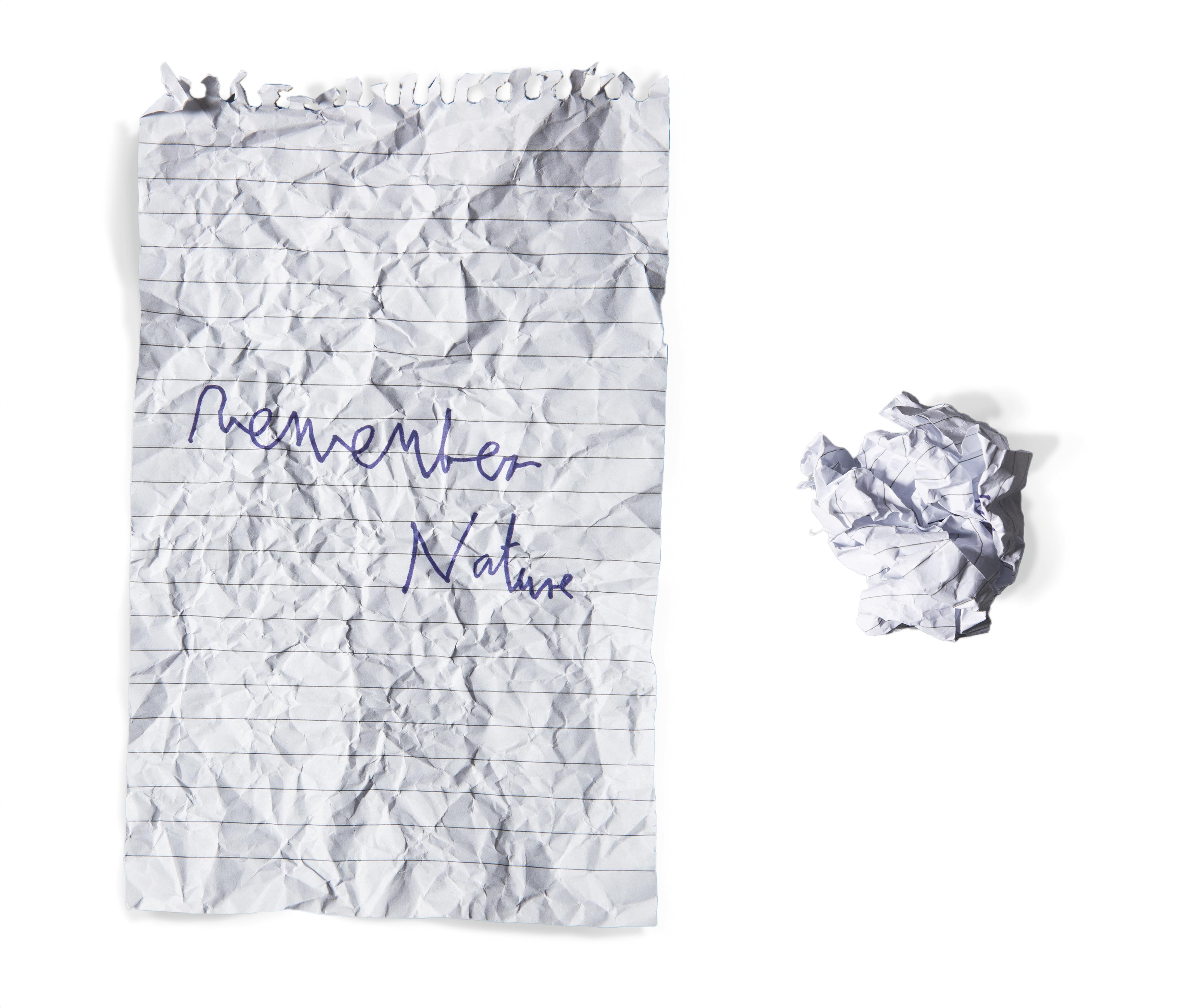
Gustav Metzger, Bruce Gilchrist and Jo Joelson (London Fieldworks), handwritten note of Remember Nature, 2015; Digital collage on notepaper. © London Fieldworks. Courtesy London Fieldworks.